Help us get the Congressional Gold Medal
to honor the World War I "Hello Girls"
During Women’s History Month 2023, legislation has been introduced in both Houses of Congress to award a Congressional Gold Medal to the U.S. Army Signal Corps telephone operators, known as "The Hello Girls."
These brave American women connected U.S. and French military forces on the front lines of World War I, but were denied veterans status or benefits for some 70 years. We are asking for your help to get this important legislation passed.
In the Senate, U.S. Senators Jon Tester (D-Mont.), Jerry Moran (R-Kan.), Maggie Hassan (D-N.H.), and Marsha Blackburn(R-Tenn.) cosponsored S.815 - A bill to award a Congressional Gold Medal to the female telephone operators of the Army Signal Corps, known as the "Hello Girls".
In the House of Representatives, U.S. Representatives Emanuel Cleaver, II (D-MO), Sam Graves (R-MO), Sharice Davids (D-KS), and Nancy Mace (R-SC) cosponsored H.R.1572 - To award a Congressional Gold Medal to the female telephone operators of the Army Signal Corps, known as the "Hello Girls".
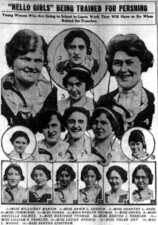
Please share this information widely, so that as many people as possible will encourage their Senators and their Representatives to support the Hello Girls Gold Medal legislation.
The Hello Girls answered their nation's call in World War I, and played an essential role supporting America's fighting forces on the front lines. In 2023, we hope America will answer the call, and tell Congress to provide the long overdue recognition of the Congressional Gold Medal.
|
American Women in World War I Sparked Remarkable Changes
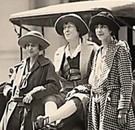
Writing on the Medium web site, author Yvonne Pipkin notes that in the early 20th Century, "It was the Cultural Norm that married women and many single women stayed home tied to the Household and did not work. So, how, and when did American women enter the workforce? The answer is U.S. involvement in World War I between 1917 and 1918." Click here to read the entire article, and learn how "a tremendous change in the social structure of the period" enabled "women to participate in many industries that had previously been the exclusive territory of men."
|
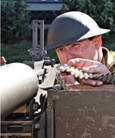
Midway Village Museum will host The Great War: World War I, featuring dozens of reenactors portraying soldiers and civilians from the United States and Europe in the museum’s historic village. Visitors engage in this unique historic, immersive experience with the opportunity to enter encampments, tour a reproduction 150-yard trench system, and watch narrated battle reenactments. Reenactors will be portraying soldiers from the US, Britain, Germany, Austria-Hungary, Russia, Greece, Turkey and even Ireland. Click here to read more, and see how you can visit encampments and see WWI uniforms, memorabilia, weapons, equipment. and much more.
|

Longtime Montgomery, AL businessman, civic leader and supporter of the military and the arts Nimrod “Rod” Thompson Frazer has died at 93. Frazer was responsible for 4 American World War I memorials: the one in France at Croix Rouge Farm in Fère en Tardenois to the Rainbow Division, and three in Montgomery, including one at Maxwell Air Force base whose inauguration triggered the coming of the Patrouille de France in 2017. Click here to read more about this combat veteran, author, and visionary philanthropist.
|
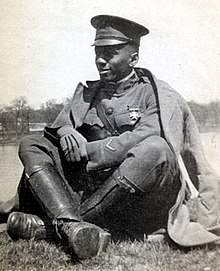
William J. Powell was a tireless promoter of African American participation in the budding field of flight. In an era when daredevil pilots captured the imagination of the masses, Powell, who served in the segregated 370th Infantry Regiment—the only regiment in the war commanded entirely by black officers—in France during WWI, recognized that aviation also presented great opportunities for African Americans and did all he could to encourage more black fliers to take to the skies. Click here to read more learn about this amazing pilot, entrepreneur, and author.
|
 |
|
World War I was The War that Changed the World, and its impact on the United States continues to be felt over a century later, as people across the nation learn more about and remember those who served in the Great War. Here's a collection of news items from the last month related to World War I and America. |
Honoring World War I “Balloon Buster” Frank Luke Jr.
Eddie Rickenbacker: America’s Most Decorated World War I Ace
True Tales About North Carolina – WWI Aviator Kiffin Rockwell
Sgt. Alvin York: The Greatest Soldier Of All Time
Private Henry Johnson’s Bravery In World War I
Mailroom Clerk Becomes The First St. Louisan To Die In WWI
Captain Peter Carey And The WWI Norcross, GA Rifle Range
West Baden Springs Hotel Was Army General Hospital In WWI
After 80 Years, Fate of USS Cythera Still Remains A Mystery
War Is Hell…On The Environment

On March 1, 2023, Daily Taps at the National World War I Memorial in Washington, DC was sounded by bugler Amy McCabe in honor of the WWI U.S. Army Signal Corps telephone operators, known as The Hello Girls, who arrived in Europe 105 years ago on 3/1/1918, and served with bravery, honor, and distinction.
Amy McCabe began her musical instruction on piano at age 6 and trumpet at age 10. After graduating in 1997 from Herscher High School in Herscher, Ill., she earned her bachelor’s degree in music and elementary education from Illinois Wesleyan University in Bloomington in 2001. She earned her master’s degree in trumpet performance in 2006 from Northwestern University in Evanston, IL. She was a featured soloist in the Tony/ Emmy award winning show Blast!, a member of MusiCorps, and has performed with the Chicago Civic Orchestra, the Spoleto Festival USA Orchestra in Charleston, S.C., and the Walt Disney World All-Star Collegiate Jazz Band and Christmas Brass in Orlando, Fla.
|
The Daily Taps program of the Doughboy Foundation provides a unique opportunity to dedicate a livestreamed sounding of Taps in honor of a special person of your choice while supporting the important work of the Doughboy Foundation. Choose a day, or even establish this honor in perpetuity. Click here for more information on how to honor a loved veteran with the sounding of Taps.
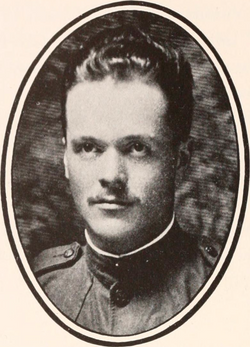
A man is only missing if he is forgotten.
Our Doughboy MIA this month fought a desperate fight, with five other brave Americans of the 27th Aero Squadron, to hold off twenty experienced German pursuit planes, saving a vulnerable Observation aircraft from attack so it could complete its mission. First Lieutenant Jason “Jay” Solon Hunt, and his five fellow Americans, flew their last mission on 1 August 1918 in the Fere-en-Tardinois sector of France.
Jason Hunt was born on 24 January 1894 in Johnson, Vermont to Bertron A Hunt and Nettie Bell Morse. His father was a lawyer and Postmaster of his hometown. Lieutenant Hunt was the eldest son and the fourth child of six in the family. On his mother’s side his great-grandfather fought in the Revolutionary War as a Private and his grandfather fought also as a Private for the Union Army in the Civil War. His brother Berton H Hunt Jr was a Sergeant Company “E” of the 101st Division AEF and survived the war. The two brothers are pictured together below.
|
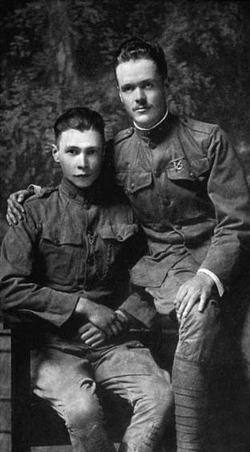
Lieutenant Hunt clearly wanted to serve his country. At the University of Vermont, he was Captain of the school’s Cadet Battalion and received a commission as a Second Lieutenant in the Vermont National Guard after his graduation in 1915. He was accepted into Harvard University’s Law program in the fall of 1915 and after completing his second year, Jason S. Hunt attend the first Officers’ Training Camp at Plattsburg, New York in May 1917. While there he was accepted into the Signal Corps Aviation program and, in July of 1917, was one of 25 candidates sent to Toronto, Canada to begin training to be an aviator. The United States Army Adjutant General Military Records show his enlistment as a Private First Class on 15 August 1917, in the city of Toronto, Canada.
In Canada Private First Class Hunt began the Officer Training Course on 1 November1917 as an Aviation Cadet. He was officially assigned a member of the 27th Aero Squadron on 24 November 1917. As winter approached Jason S. Hunt and his fellow Cadets were sent to Texas to complete flight training. Cadet Hunt was assigned to Taliaferro Field, Fort Worth, Texas and received his commission as a First Lieutenant, Reserve Aviator on 12 January 1918.
|
The 27th Aero Squadron departed Texas on 23 January 1918. They arrived in Garden City, New York three days later , just in time to be quarantined for a scarlet fever epidemic. On 26 February 1918 the 27th Aero Squadron departed New York on the SS Olympic (ship 527) arriving in England on 5 March 1918. By the end of the month Lieutenant Hunt and the 27th Aero Squadron would arrive at the American Aviation School in Issodun for more advanced flight training. During Lieutenant Hunt’s training at Issodun, he was injured in a flying accident on 24 April 1918. But he completed his training before the Squadron moved to the front.
27th Aero Squadron moved forward arriving first at Epies and then on to Toul by 1 June 1918. On 2 June 1918 the 27th Aero Squadron started forward operations in the combat zone. Lieutenant Hunt would fly his first combat patrol on 3 June 1918 as part of “A” Flight patrolling the Toul sector to protect allied balloons. The Squadron moved on to Touquin, France on 26 June 1918 and then to Saints on 8 July 1918 to patrol the forward area of the Chateau-Thierry sector.
On 15 July 1918 during a low patrol mission between Chateau-Thierry and Verneuil from 4:45 to 6:30 in the morning, at about 1,000 feet, Lieutenant Hunt was forced to crash land at Montolievet without serious injury. Three days later LT Hunt made a forced landing at Noirlieu while on patrol between Chateau-Thierry and Faverolles. Lieutenant Hunt had participated in 31 combat patrols before 1 August 1918. During those missions only once did he engage the enemy combat.
At 7:05 in the morning of 1 August 1918 Lieutenant Hunt took off with 17 other members of the squadron to perform three separate missions flying the agile yet unreliable Nieuport 28s. Two flights were ordered to protect one Salmson 2A2 Observation aircraft each and one flight was ordered to attack and destroy a German Observation Balloon. Lieutenant Hunt’s flight of six Nieuports operated in the Fere-en-Tardenois region providing high cover for the Salmson at 10,000 feet.
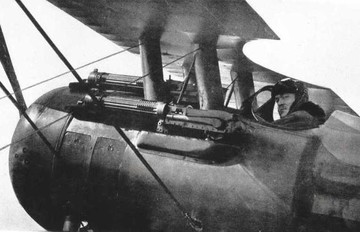 LT Jason Hunt in the cockpit of his Nieuport 28.
Lieutenant Hunt and the rest of the flight were initially attacked by eight Fokker biplanes just east of Fere-en-Tardenois at 8:10 in the morning. The battle was quickly joined by a mix of twelve Fokker and Albatross pursuit fighters. Grossly outnumbered, the six American pilots, Lieutenants Hunt, McElvain, Sands, Martin, Whiton, and Beauchamp, stayed to fight at odds greater than three to one. Each did his best to protect the Observation plane, which made it back to safety to its squadron, but at the cost all six 27th Aero Squadron Nieuports.
Lieutenant Hunt was shot down by Leutnant Egon Koepsch of Jasta 4 for his fifth victory, making him an ace. Leutnant Koepsch would survive the war with a total of nine victories to his credit.
Since all members of the flight failed to return it is not known what exactly happened to Lieutenant Hunt. After the war the German government informed the American Grave Registration Service, Lieutenant Hunt’s aircraft came down between the villages of Leges and Jouaignes near the two chateaus of Chateau de Virly and was buried next to his aircraft. Grave Registration Service investigators responded to the area in 1924 and learned Lieutenant Hunt’s remains were moved by the French Civil Service in 1922.
The burned out hulk of Lieutenant Hunt’s aircraft was still located about 150 meters northwest of the western chateau of the Chateau de Virly compound. With help from the Gardner/Caretaker of the chateau, Investigators located evidence of a previous grave at the edge of a wood that still exists today. The Caretaker had witnessed the aircraft come down and knew an American aviator had died in the crash. German Soldiers stationed nearby had buried Lieutenant Hunt next to his aircraft. On his grave respectful German Soldiers put a cross with an inscription declaring: Ici repose un Aviateur mort pour la France. “Here rests an Aviator who died for France.”
After Lieutenant Hunt was exhumed and moved by the French his whereabouts became a mystery, as local French Civil Servants did not keep accurate records of the movement of unidentified remains. Because of the wording on the cross erected by the Germans it is possible French officials thought Lieutenant Hunt was French and may have buried him as an unknown French aviator. His remains were badly burned as witnessed by the Caretaker. To date no one is sure where Lieutenant Hunt’s final resting place is and therefore he is listed as Missing in Action by the United States.
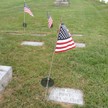
The family of Lieutenant Hunt never gave up on locating his remains. His sister worked very hard to find information about his grave. As a result, the family believes just after World War II, Lieutenant Hunt’s brother in law, Captain Norman L Scott, informed his sisters that he found the grave in a French Military Cemetery. Unfortunately, over time, the family has lost the name of the cemetery Captain Scott found.
Doughboy MIA has an Aviation Team dedicated to locating missing in action American Aviators of World War One. Lieutenant Hunt’s MIA case is actively being researched with the goal of finding and repatriating his remains. Until accomplished, First Lieutenant Jason Solon Hunt is listed on the Tablets of the Missing at the Aisne-Marne American Military Cemetery, and has a cenotaph alongside his mother and father in the Horse Meadow Cemetery, North Haverhill, New Hampshire.
Would you like to be involved with solving these cases? You can! Click here to make a tax-deductible donation to our non-profit organization today, and help us bring them home! Doughboy MIA will be mounting another mission to France this summer. Help us do the best job possible and give today, with our thanks.
|
Merchandise from the Official
Doughboy Foundation WWI Store
|